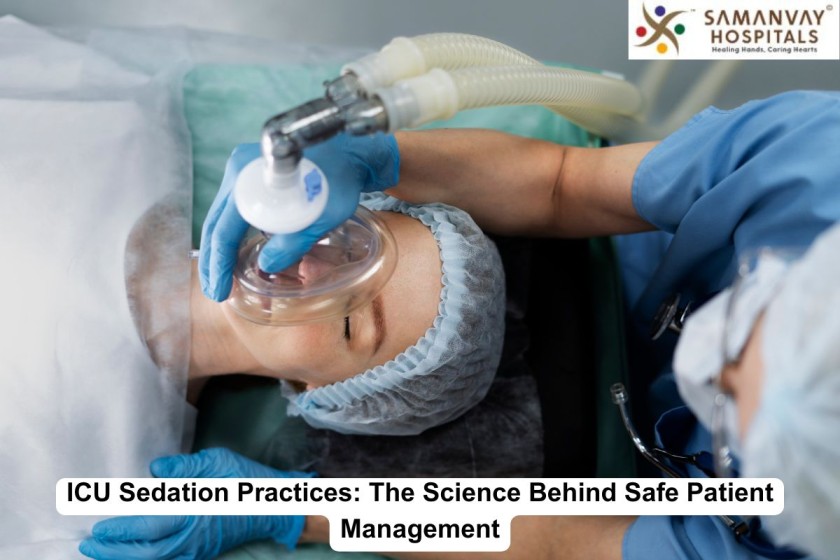
Table of Contents
- Introduction
- What is ICU sedation?
- Why is sedation important in ICU?
- Types of sedation used in ICU
- Principles of safe sedation practices
- Monitoring sedation in ICU patients
- Challenges in ICU sedation management
- Innovations in ICU sedation
- Role of hospitals in India in ICU sedation practices
- Conclusion
- FAQs
Introduction
Intensive Care Units (ICUs) treat patients with serious illnesses or injuries. In most situations, ICU sedation practices is required to relax and keep these patients calm. It is useful in eliminating pain, stress, and anxiety while receiving treatment. Safe sedation is highly essential to prevent risks or side effects. In this blog, we’ll discuss how sedation is used in the ICU. We will also see what the science behind it is and how the hospitals ensure the safety of the patients. This data is useful for families and healthcare staff as well. Further, we will discuss the newer techniques employed in ICUs currently. We aim to provide easy, understandable information regarding safe and efficient sedation practices employed globally.
What is ICU sedation?
ICU sedation refers to administering medicines to make the patients calm and relaxed. It is most commonly used when patients are ventilator-dependent or require painful procedures. Sedation decreases stress, pain, and fear. Sedation prevents patients from pulling out tubes or moving excessively. There are varying degrees of sedation, ranging from light to deep. The aim is to make patients comfortable but remain safe. Excessive sedation hinders healing. Inadequate sedation makes patients uncomfortable and anxious. It is for this reason that the correct balance is extremely crucial. Nurses and doctors should know how sedation works. This enables them to look after patients in the safest manner. Correct sedation enhances patient recovery and comfort in the ICU.
Why is sedation important in ICU?
ICU sedation plays a number of important roles:
- Alleviates pain during procedures.
- Decreases agitation and anxiety.
- Anticipates accidental removal of tubes.
- Increases tolerance of mechanical ventilation.
- Increases patient safety and comfort.
However, bad sedation can lead to complications. Sedation lasting for a long time can result in longer stays in the ICU. It might lead to breathing difficulties or cognitive problems. Hence, sedation should be well managed by experienced personnel. Baroda’s best hospital specialists stress safe sedation for better outcomes.
Types of sedation used in ICU
Sedation in the ICU uses a range of drug classes. Each is used for particular purposes and has side effects.
- Benzodiazepines: Reduce anxiety and promote sleep.
- Propofol: Offers rapid-acting sedation with rapid recovery.
- Opioids: Treat severe pain, often in combination with sedatives.
- Dexmedetomidine: Offers sedation with less respiratory depression.
Selecting the appropriate sedative is based on patient requirements. Additionally, medication dosing has to be customised to ensure safety. Moreover, some patients need continuous sedation, whereas others require intermittent administration.
Principles of safe sedation practices
Safe ICU sedation relies on some crucial principles that ensure patient protection:
- Use the minimum effective dose: Always administer the minimum amount of medication required to make the patient calm and safe. This minimizes side effects and accelerates recovery.
- Monitor sedation levels regularly: Nurses and physicians must monitor the patient’s level of sedation frequently. This makes sure that the patient is not over-sedated or under-sedated.
- Avoid deep sedation when possible: Deep sedation should be avoided unless it is truly needed. Lighter sedation helps patients wake up faster and lowers risks.
- Combine sedation with pain control: Pain and sedation should be managed together. Treating pain properly can reduce the need for strong sedatives.
- Use sedation protocols and guidelines: Following standard procedures makes sedation safer and more effective for every patient.
- Train personnel in sedation management: Properly trained personnel can identify problems early and modify treatment rapidly.
Furthermore, Indian hospitals implement these regulations to deliver safe, high-quality ICU care.
Monitoring sedation in ICU patients
Monitor constantly while sedating. It helps the patient stay within desired sedation ranges. Popular tools are
- RASS (Richmond Agitation-Sedation Scale): Measures sedation depth.
- SAS (Sedation-Agitation Scale): Assesses agitation and sedation.
- BIS (Bispectral Index): Monitors brain activity through EEG.
Moreover, monitoring enables timely adjustment of sedative doses. It avoids over- or under-sedation. Nurses also have a key role in sedation monitoring. They report changes immediately for immediate intervention.
Challenges in ICU sedation management
Sedation in the ICU has several challenges:
- Unpredictable patient response to sedatives.
- Risk of respiratory depression.
- Risk of delirium and cognitive impairment.
- Balancing sedation with analgesia.
- Managing sedation in patients with organ dysfunction.
These situations demand experienced clinical judgment. Hence, sedation care is a collective effort. Additionally, family participation and effective communication support care. Baroda’s best hospital and other Indian hospitals provide training to staff. This ensures sedation care is up to international safety standards.
Innovations in ICU sedation
New developments enhance ICU sedation safety:
- Implementation of patient-feedback-based sedation protocols.
- Incorporation of non-pharmacologic interventions such as music therapy.
- Design of short-acting sedatives.
- Use of electronic sedation monitoring equipment.
- Emphasis on sedation vacations to minimize drug exposure.
These innovations lower complications and decrease recovery times. Therefore, numerous hospitals in India are opening these new practices. They aid in optimizing sedation and increasing patient comfort.
Role of hospitals in India in ICU sedation practices
Indian hospitals are rapidly improving ICU care. Several have implemented
- Standard sedation regimens.
- Staff training programs.
- State-of-the-art monitoring devices.
- Multidisciplinary sedation teams.
For example, Baroda’s best hospital excels in critical care. It promotes safe sedation to enhance patient survival. Such practices are in line with international ICU sedation guidelines. As a result, patients get safer, more effective treatment.
Conclusion
Safe ICU sedation is extremely crucial for patient comfort and quicker recovery. It requires proper selection of drugs, constant monitoring, and strong teamwork. Properly done, sedation makes patients feel less stressed and less pain. Besides,using clear procedures can avoid issues such as respiratory problems and disorientation. New techniques and improved staff training also make sedation safer. Most Indian hospitals practice these enhanced routines now. For example, Baroda best hospital emphasizes safe and contemporary sedation treatment. Knowing how sedation works assists physicians and nurses in providing quality treatment. Healthcare teams worldwide can benefit from this information. Safe sedation translates to improved outcomes and easier healing for ICU patients.
FAQs
- Why are patients in the ICU sedated?
Sedating comfortable, painless, and secure ICUs with medical treatment and procedures like ventilation.
- Is deep sedation administered to all ICU patients?
No, deep sedation is only used in a situation of extreme need. Light sedation is less likely to cause side effects and recovery time.
- How do hospitals provide safe sedation?
Hospitals follow routine procedures, are extremely careful with patients, and regularly train staff to allow for safe and effective sedation in the ICU.







